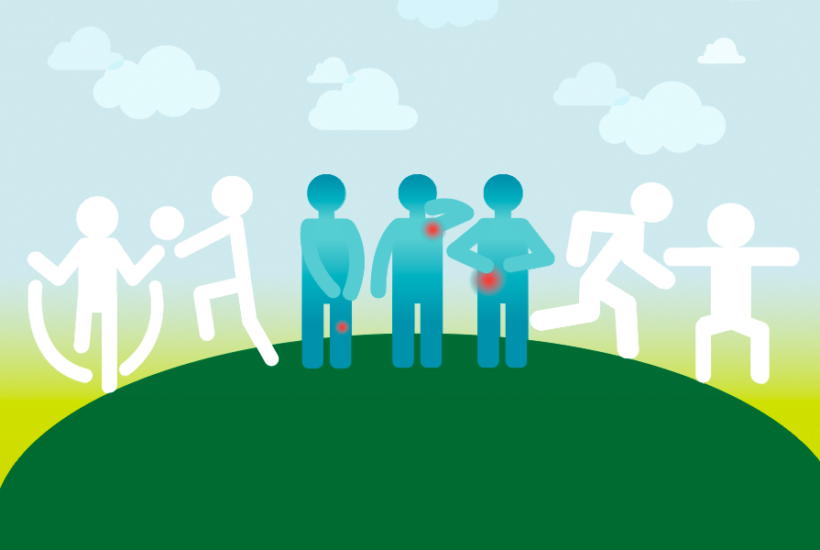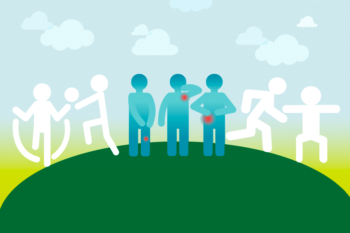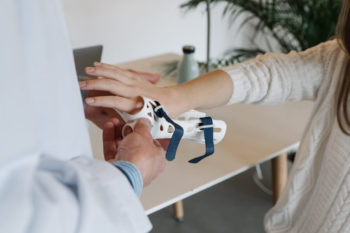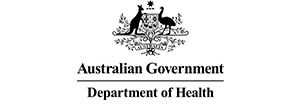Preventing the development of chronic pain

Status completed
Start Date
End Date
Chronic non-cancer pain is a major public health issue and has been classified as a disease in itself through the World Health Organization. Chronic pain affects approximately one in five people in Australia.
This project worked with Primary Health Networks (PHNs) to increase understanding around opportunities to improve the secondary prevention and management of chronic pain in primary care.
Introduction
The project team developed a framework of options to address the management and secondary prevention of chronic pain for PHN decision-makers. It also played an important role in supporting collaboration and information sharing between PHNs to support implementation.
Featured project resources
-
Research seminar: Preventing and managing chronic pain in primary care
Resource category:Videos
Date -
Supporting PHNs to reduce the burden of chronic pain
Resource category:Findings Brief
Date -
Addressing chronic pain – one of our biggest health problems in Australia
Resource category:Podcasts
Date
Featured project news
-
Primary Health Networks as primary research sites
News Category: Prevention Centre NewsDate -
Investigators’ Forum and the future of chronic disease prevention
News Category: Prevention Centre NewsDate -
New chronic pain resources for primary care
News Category: Prevention Centre NewsDate
About
Preventing and better managing chronic pain in primary care
Project titleWhat is the issue?
- Chronic non-cancer pain is a major public health issue and has been classified as a disease in itself through the World Health Organization.
- Chronic pain affects approximately one in five people in Australia and is increasing due to the ageing population.
- Chronic pain can lead to poorer quality of life, depression and anxiety, loss of income and premature retirement, and create feelings of stigmatisation and exclusion.
- The total economic cost of chronic pain in Australia is high, estimated as A$139 billion in 2018, through reduced quality of life, productivity losses and direct health system costs.
- Tertiary pain services have long waiting lists and are unable to meet increasing demand.
- Primary care is a crucial intervention point to improve access to multidisciplinary pain care
How did our project address the issue?
- Our project focused on Australia Primary Health Networks (PHNs) given their remit to support primary care and to commission services to address local needs.
- The project had two overall aims:
- To synthesise knowledge about the secondary prevention and management of chronic pain
- To improve knowledge, knowledge-sharing and knowledge use among PHNs about options to address the secondary prevention and management of chronic pain in primary care
- We had a high level of engagement with PHNs, consulting with executive level staff and program leaders from most PHNs across Australia
The project had three phases, outlined below.
Phase 1 – needs, priorities and gaps related to chronic pain
- A review of publicly available core PHN Needs Assessments
- Consultation (via telephone interviews and online surveys) with PHNs to understand their needs, priorities and gaps related to chronic pain
- Mapping of PHN chronic pain initiatives
- Workshop with PHNs to discuss chronic pain initiatives
Phase 2 – secondary prevention of chronic pain
- A deliberative dialogue with PHNs about options to address the secondary prevention of chronic pain informed by a rapid evidence review
Phase 3 – community-based pain programs
- eDelphi survey of experts to establish consensus on the key elements and enablers to implementation of community-based pain programs
- Online survey and consultation (via email) of PHNs about the features of their community-based pain programs; and program adaptations during the COVID-19 pandemic
What were the outcomes?
- A scoping literature review to identify the evidence related to the secondary prevention and management of chronic pain in primary care in Australia
- Understanding the needs and priorities of PHNs related to the secondary prevention and management of chronic pain in primary care
- Improving knowledge among PHN decision-makers about chronic pain and options to address the secondary prevention and management of chronic pain
- Mapping current PHN chronic pain initiatives and identifying gaps
- Identifying two exemplar evidence-based initiatives suitable for scale-up across PHNs in Australia: multidisciplinary community-based pain programs, and an online health professional capacity-building initiative, Project ECHO (chronic pain)
- Highlighting key enablers to implementation of PHN chronic pain initiatives
- Highlighting solutions identified by PHNs to increase capacity to commission initiatives
What is the relevance for policy and practice?
- PHNs could do more to improve the secondary prevention and management of chronic pain
- A self-identified need for greater collaboration across PHNs and co-commissioning with local and state governments and non-government partners would help to build PHN capacity
- Exemplar evidence-based initiatives to improve the secondary prevention and management of chronic pain could be scaled-up across PHNs in Australia
News and media
-
Primary Health Networks as primary research sites
News Category: Prevention Centre NewsDate -
Spotlight on managing chronic pain
News Category: Prevention Centre NewsDate -
Investigators’ Forum and the future of chronic disease prevention
News Category: Prevention Centre NewsDate -
New chronic pain resources for primary care
News Category: Prevention Centre NewsDate -
Putting chronic pain on the map: PHNs meet to discuss prevention and management
News Category: Prevention Centre NewsDate -
Minister launches project to tackle chronic pain
News Category: Prevention Centre NewsDate -
New research project to help tackle chronic pain
News Category: Media releasesDate
Resources
-
Research seminar: Preventing and managing chronic pain in primary care
Resource category:Videos
Date -
Supporting PHNs to reduce the burden of chronic pain
Resource category:Findings Brief
Date -
Addressing chronic pain – one of our biggest health problems in Australia
Resource category:Podcasts
Date
Other resources
- Chronic pain resources: A summary of online and accessible initiatives and resources, March 2019
- Community pain programs factsheet: Managing chronic pain who can help?
Video
- 9 December 2020, Preventing and better managing chronic pain in primary care final project steering group presentation
Publications
Other publications
Presentations
- Project team, Preventing and better managing chronic pain in primary care final project steering group presentation, 9 December 2020
- Simone De Morgan. The role of Primary Health Networks in improving the prevention and management of chronic pain in primary care at the Emerging Health Policy Research Conference, 27 June 2019.
- Simone De Morgan. Poster presentation on the Review of Primary Health Network chronic pain initiatives at the Australasian Association for Academic Primary Care (AAAPC) Conference, University of Adelaide, 12 July 2019.
- Pippy Walker. Menzies Centre Emerging Health Policy Research Conference, University of Sydney, 26 July 2018.
- Poster presentation, Australian Pain Society Meeting, Sydney, 9 April 2018
People
Lead investigators
Project team
-
Professor Andrew Wilson AO
The University of Sydney -
Pippy Walker Pippy Walker has finished working with the Prevention Centre.
The University of Sydney -
Dr Simone De Morgan
The University of Sydney -
Leah Marks
The University of Sydney -
Dr Samantha Rowbotham
The University of Sydney













